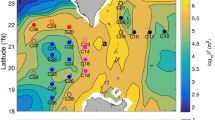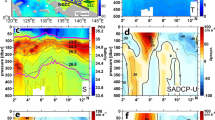Abstract
RECENT measurements of microstructure in the ocean1–4 have led to considerable speculation about physical processes that lead to a steplike distribution of temperature, salinity and velocity. Briefly, one school of thought explains the microstructure in terms of interleaving of layers originating at different locations1,2. The other school suggests that the transport processes responsible for the vertical diffusion of heat, salt and momentum may inevitably result in the development of layers; the most striking theory, the so-called salt finger mechanism developed by Turner, Stommel and Stern5–7, depends on the difference between the molecular diffusivities for salt and heat. This mechanism works only in a statically stable ocean where the temperature gradient is stable, but the salinity gradient is unstable, or in the reverse situation. Tait and Howe3 have recently published profiles that strongly favour the salt-fingering process for layers under the Mediterranean outflow, but regular steps in temperature and salt of this kind are rare: the great majority of ocean microstructure is much more variable. Dr R. W. Stewart (private communication) has suggested that this microstructure is caused by the difference between the (turbulent) transport coefficients for buoyancy and momentum. No adequate theory for this buoyancy–momentum process has yet been developed, but the low Reynolds number turbulent spots discovered by Woods8,9 may be important. Temperature microstructure in a freshwater lake at least demonstrates that salinity gradients are not an essential factor in the generation of ocean microstructure. The occurrence of such microstructure in freshwater lakes seems likely from transparency observations made by Whitney11.
This is a preview of subscription content, access via your institution
Access options
Subscribe to this journal
Receive 51 print issues and online access
$199.00 per year
only $3.90 per issue
Buy this article
- Purchase on Springer Link
- Instant access to full article PDF
Prices may be subject to local taxes which are calculated during checkout
Similar content being viewed by others
References
Stommel, H., and Federov, K. N., Tellus, 19, 306 (1967).
Cooper, L. H. N., Science Progress, 55, 73 (Oxford, 1967).
Tait, R. I., and Howe, M. R., Deep Sea Res., 15, 275 (1968).
Cooper, J., and Stommel, H., J. Geophys. Res., 73, 5849 (1968).
Turner, J. S., and Stommel, H., Proc. US Nat. Acad. Sci., 52, 49 (1964).
Turner, J. S., Deep Sea Res., 14, 599 (1968).
Stern, M. E., J. Fluid Mech., 35, 209 (1969).
Woods, J. D., Met. Mag., 97, 65 (1968).
Woods, J. D., J. Fluid Mech., 32, 791 (1968).
Woods, J. D., Underwater Sci. Tech. J., 1, 6 (1969).
Witney, L. V., Science, 85, 224 (1937).
Jones, P., thesis, Univ. North Wales (1969).
Woods, J. D., Radio Science, 4, 1289 (1969).
Cox, C. S., Hacker, P. W., Johnson, B. P., and Osborn, T. R., Proc. Marine Temperature Measurement Symp., 95 (Marine Technology Soc., Washington DC, 1969).
Author information
Authors and Affiliations
Rights and permissions
About this article
Cite this article
SIMPSON, J., WOODS, J. Temperature Microstructure in a Fresh Water Thermocline. Nature 226, 832–835 (1970). https://doi.org/10.1038/226832a0
Received:
Revised:
Issue Date:
DOI: https://doi.org/10.1038/226832a0
This article is cited by
-
Structure and dynamics of the stratosphere and mesosphere revealed by VHF radar investigations
Pure and Applied Geophysics PAGEOPH (1980)
-
Internal waves in llyn Tegid
Pure and Applied Geophysics PAGEOPH (1973)
-
On the gravitational potential energy of vertically stratified water columns
Pure and Applied Geophysics PAGEOPH (1972)
-
Asymmetry of the Internal Seiche in Loch Ness
Nature (1971)
Comments
By submitting a comment you agree to abide by our Terms and Community Guidelines. If you find something abusive or that does not comply with our terms or guidelines please flag it as inappropriate.



